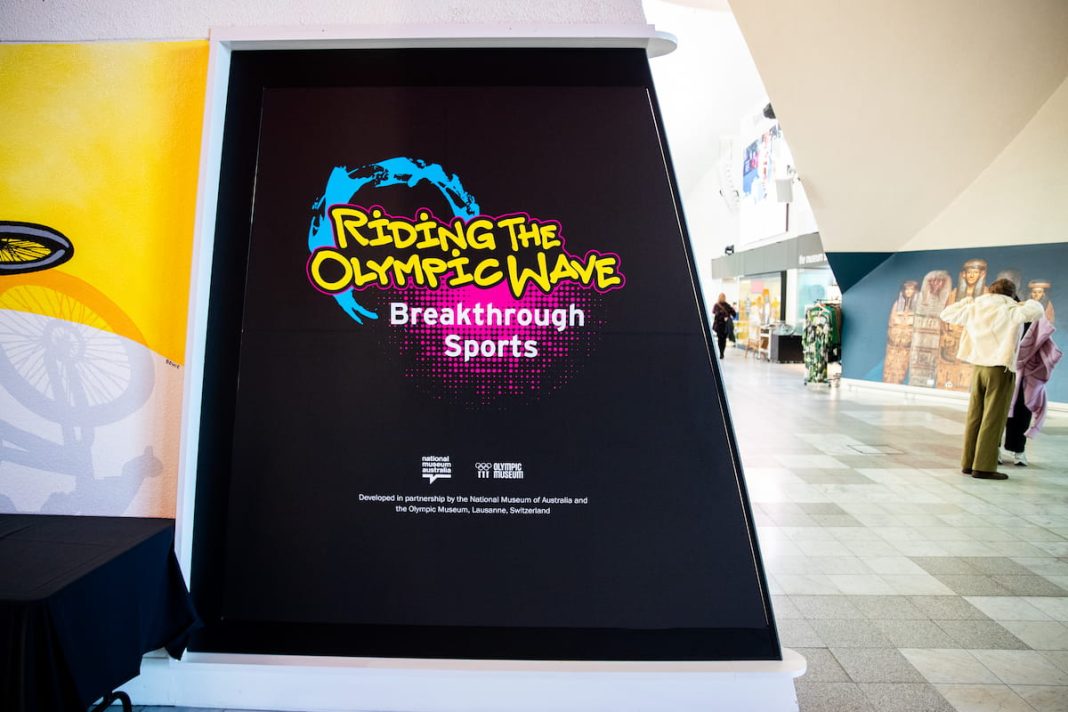Riding the Olympic Wave: Breakthrough Sports is a co-production between the Olympic Museum in Lausanne, Switzerland, and the National Museum of Australia. The exhibition emphasises the significant differences between the upcoming Paris Olympic Games and its predecessor, the Sydney 2000 Games.
For the first time in Olympic history, Paris 2024 will feature breaking (breakdancing). Additionally, 3×3 basketball, BMX freestyle, skateboarding, sport climbing, and surfing, which debuted at the Tokyo 2020 Olympic Games, will all be returning.
The featured sports all evolved out of youth culture and have developed their own unique environments of art, fashion, film and design. Riding the Olympic Wave investigates the dramatic arrival of these new disciplines and their role in bringing about the most significant transformation of the Olympic Movement in recent times.
National Museum director Katherine McMahon praised the exhibition for its appeal to new audiences.
“This dynamic exhibition explores how youth sports culture has transformed the Olympics for a new generation – we’re so pleased to bring this story alive by bringing this show to Australian audiences,” Ms McMahon said.
The exhibition was inspired by the Olympic Museum’s most successful temporary exhibition to date: Riding the Olympic Wave (2022–23). An additional adaptation, entitled SPOT24 – The Olympic Exhibition on Sport and Urban Cultures, was co-produced by the Olympic Museum and the Paris tourism office, Paris je t’aime. SPOT24 opened in Paris on 3 April 2024 and will be on show until 31 December 2024.
Olympic Museum director Angelita Teo said, “It is wonderful to see this exhibition tailored for an Australian audience, creating opportunities for dialogue and conversation ahead of the Olympic Games Paris 2024 and building excitement and anticipation for Brisbane 2032.”
Olympic Museum director Angelita Teo expressed her enthusiasm for the exhibition.
“It is wonderful to see this exhibition tailored for an Australian audience, creating opportunities for dialogue and conversation ahead of the Olympic Games Paris 2024, and building excitement and anticipation for Brisbane 2032,” she said.
Australian Olympic Committee president Ian Chesterman said he was excited about the exhibition and the upcoming Olympics.
“The sports featured in this excellent exhibition reflect the evolution of the Games from the first modern Olympics – Athens 1896, to the Olympics in the 21st century – Paris 2024,” Mr Chesterman said.
“We had one Australian Olympian at those inaugural Games in Edwin Flack and this year we expect to take around 460 athletes including athletes from the urban sports showcased in this exhibition.
“We have already selected surfers, sports climbers and breakers, while athletes from 3×3 basketball, skateboarding and BMX will be named in the coming weeks.
“This is a significant collaboration between the National Museum of Australia and the Olympic Museum, one we hope will continue to flourish as we head towards our home Olympics in 2032.”
The Riding the Olympic Wave exhibition delves into Australia’s century-long relationship with the Olympic Games, highlighting six sports and disciplines. The exhibition design and programming emphasise the social, cultural, and artistic contexts in which these sports thrive.
Sometimes described as urban sports or even extreme sports, these youth-focused disciplines spontaneously broke away from traditional sports practices and spread internationally in the 1960s and 1970s.
The common denominator between these sports is a grassroots evolution that took place as a result of young people developing their own modes of play, creativity and competition within their communities. Their philosophy and lifestyle are often starkly different from other sports.
National Museum curator Dr Jono Lineen praised the innovative and contemporary elements of the exhibition.
“Riding the Olympic Wave is a great way for the National Museum to highlight not just these incredible new sports, but the art, music, fashion and film that have evolved around them. Street art, poster art, music-style video production, fashion, street performance and contemporary music are all elements that have been incorporated into the exhibition design and programming of the exhibition,” Dr Lineen said.
“This is the first but definitely not the last exhibition that the National Museum will develop that taps into the essence of youth culture. Museums help us make sense of the past, but understanding history helps us adapt to the future,” Dr Lineen said.
Riding the Olympic Wave will include a series of artistic installations that highlight the close ties between contemporary art, culture and sport.
The exhibition will be on display in the National Museum of Australia’s Gandel Atrium until 30 September 2024.
Exhibition highlights
- Signed shirt worn by BMX freestyle Olympic champion Logan Martin, Australia, during the Olympic Games Tokyo 2020.
- Signed rashie worn by Olympic bronze medallist Owen Wright, Australia, during the Olympic Games Tokyo 2020.
- Pair of 3×3 basketball shoes worn by Olympic champion Nauris Miezis, Latvia, during the Olympic Games Tokyo 2020.
- Skateboard deck used by Olympic champion Yuto Horigome, Japan, during the Olympic Games Tokyo 2020.
- Pair of climbing shoes worn by Olympic champion Janja Garnbret, Slovenia, during the Olympic Games Tokyo 2020.
- Sweatshirt worn by breaking double Youth Olympic champion B-girl Ram (Ramu Kawai), Japan, during the Youth Olympic Games Buenos Aires 2018.
- Torch used during the Olympic Games Sydney 2000 torch relay.
- Torch used during the Olympic Games Melbourne 1956 torch relay.
- Running singlet worn by Peter Norman, Australia, silver medallist at the Olympic Games Mexico 1968 and known for his involvement in the black power movement protest on the medal dais for the 200-metre race.
- Team blazer worn by Olympic champion Edgar ‘Dunc’ Gray, Australia, when flagbearer at the Opening Ceremony for the controversial Olympic Games Berlin 1936.



